Alaska Fish & Wildlife News
February 2024
Among the Bears at McNeil
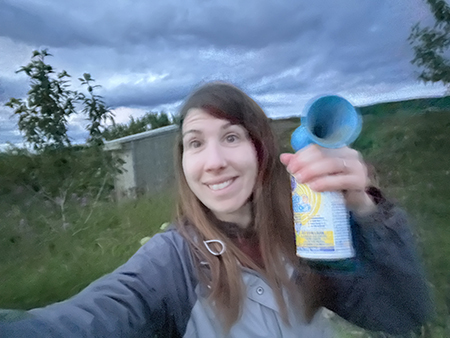
I grabbed the airhorn I was given upon arrival, took a ridiculous blurry selfie while holding it, and sang a little song as I walked back to my tent from the outhouse just as darkness fell over McNeil River State Game Sanctuary in August of 2022. If I was going to get mauled by a bear tonight, at least I would have photographic evidence of the airhorn, meant to scare off any bears that entered camp, that failed me.
I had landed at McNeil just before 9 p.m. and in those first two hours had pitched my tent, attended a safety meeting with the group, and separated out all my food and “smelly” items to leave in the cook cabin where I prepared my French press for coffee in the morning. In a place where I was with total strangers for the next five days, the last thing anyone needed was for my inner caffeine-lacking troll to crawl out of its cave and get snappy with everyone in the morning in our communal area. Back in my tent, as I snuggled into my sleeping bag with my trusty airhorn, the questions I had been asked by family and friends came reeling through my mind. “You’re not taking a gun? You don’t have bear spray? ARE YOU INSANE?” But, as the wind whipped my tent fly around, my fears turned into excitement for the coming day and I fell into a solid sleep, only waking once to the distant roars of two bears engaged in what I thought had to be an epic and violent brawl out on the river.
McNeil River State Game Sanctuary, nestled along the shores of Lower Cook Inlet in Southwestern Alaska, is recognized as one of the most incredible places on the planet to view brown bears throughout the summer. Known to photographers and bear enthusiasts, McNeil is the paramount location for brown bear viewing. I’m not going to lie, living in Alaska for 10 years I had vaguely heard of McNeil, but only really learned about it when I took a new job with the Alaska Department of Fish and Game that tasked me with working on the McNeil permit raffle. My coworkers quickly brought me up to speed on the sanctuary, but soon realized it would be best for me to experience it for myself. This journey took me to Homer, where I boarded a floatplane and flew 100 miles, landing me in a saltwater lagoon abutted by a remote campground that has gone unchanged for decades. Since the late 1960s, the sanctuary has been managed by the Alaska Department of Fish and Game staff, allowing a limited number of visitors to protect this unique congregation of bears. I learned that as one of the lucky visitors of the sanctuary, my behavior would be structured and predictable. This meant putting smelly things in the cook cabin, so the bears would not be exposed to human attractants. It meant on the daily bear viewing excursions, doing exactly as my bear guide told us to do so our human behavior was as predictable to the bears as the tide cycle. With humans behaving the exact same way in the sanctuary for decades, the bears within the sanctuary have become “habituated” to human visitors, meaning humans are neutral on the landscape and present neither a threat nor a curious temptation to the bears. Knowing all of this going into the sanctuary and the fact that no one has ever been injured by a bear at McNeil, I felt incredibly fortunate that I lucked into going to such a unique and special place.
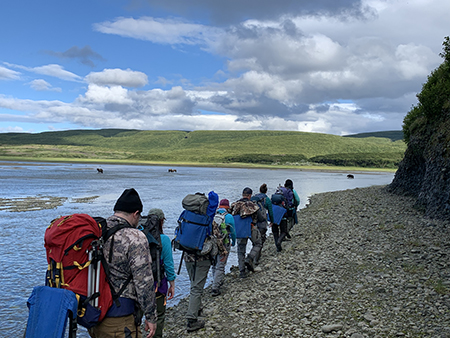
Around 8 a.m., I unzipped my tent fly to a beautiful calm sunny August morning and scrambled into the cook cabin to my French press. Luckily for me (and probably them), some of the other visitors had already started the tea kettles and had hot boiling water at the ready. At McNeil, water must be filtered with a personal water filter, or boiled for at least 5 minutes in a kettle, since it comes from a small creek just outside of camp. The fact that my companions had taken the time to do this for everyone made me appreciate their presence even more, although I admittedly hadn’t figured out all of their names yet. At 9 a.m. we had our morning meeting with McNeil staff, where we planned our day of bear viewing, which would go from 10:30 a.m. to 7 p.m., a standard schedule for McNeil bear viewing days, shifting only slightly based on the tide cycles.
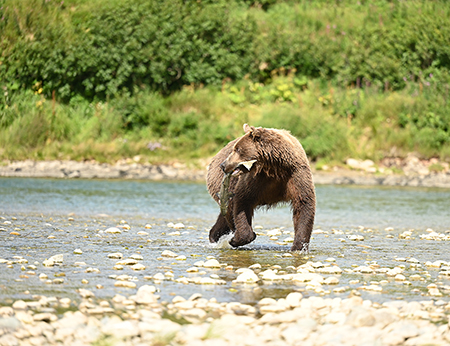
We met at the “Mushroom chair” at 10:30 a.m., ready to embark on our day of bear viewing. The mushroom chair represents the furthest point that visitors are allowed to venture without a guide and the furthest point bears are allowed into camp without being reminded to leave, which is done by McNeil staff clapping their hands. It’s a unique spot, where bears can pass by you at close distance while you drink your morning coffee or tea as they travel along the beach. Our meeting at the mushroom chair was simple - we needed to travel together in a tight group within the sanctuary and stay on the path. Our goal was to cross the lagoon during low tide, traverse to another path, and drop back down to the river. The walk to McNeil River, and most bear viewing areas at McNeil, involves some moderate paths through running water, mud, and short hilly areas. Some of my companions were wearing hip boots, but I stuck with wearing my good fishing waders (which I had cleaned the ever-loving heck out of to remove fish smells before going to McNeil). I was thankful for the solid foot support I had from my nicer wading boots, since we walked about 5 miles per day.
By the time we reached the bank of McNeil River, we were greeted by sunshine, a light breeze, and four brown bears fishing for chum salmon. We all settled along the gravel bar in an area that gave the bears plenty of ample access to move around and fish, sat in our packable chairs (provided by Friends of McNeil and ready for the taking in the cook cabin), grabbed a snack and our cameras, and just took in the experience of being there. Within a half hour, our first very close bear encounter happened when a sub-adult male brown bear grabbed a salmon, ran over to the gravel bar we were on, and started chomping away, not fifteen yards from all of us. He was close enough that we could starkly hear all of the bones crunching in the salmon he was chewing on, and his jowls slapping as he devoured his fish. He finished his meal, went back in the river, and promptly caught another salmon. This time, two other bears decided they wanted to try to steal his meal, and the bear duo moved in pursuit towards the bear with the fish (and us)! All three of the bears ended up running along the gravel bar feet from us. It was unfathomable to me in that moment that we humans seemed so irrelevant to the bears. They were just being bears, and we were the predictable boring blobs taking photos of them.
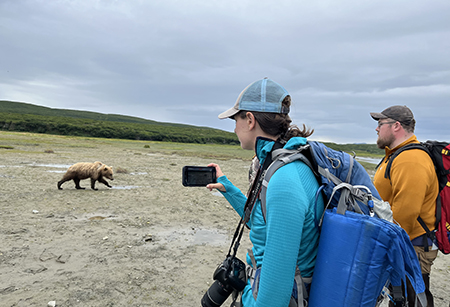
By a stroke of amazing luck, a great friend of mine, Courtney, also had a viewing permit for McNeil and flew into the sanctuary the day after me. Although I wasn’t really scared alone in my tent that first night, it was nice to have another human in there with me…just in case. I still didn’t quite trust the airhorn against an approaching bear, and perhaps I subconsciously thought Courtney would be my human shield in a bear tent incident? Nonetheless, I was so excited for her to get to experience what I had during my first day, since I knew she had never had a close experience with a brown bear before. Like our first day, we had a morning meeting at 9 a.m. and left for bear viewing at 10:30 a.m., ready for a day of new experiences with the bears. We had the same plan as the day before - cross the sedge flats, head across the lagoon, and watch bears along the river. Just before we crossed the lagoon, we ran into a bear that we had dubbed “Little Bear” the day before. This bear was digging for salmon scraps in the mud at the lagoon. We stood in our tight line watching and Little Bear decided to walk right up to us. Picture a friend’s cautious cat wanting to come check you out, but still keeping a guarded distance. That was Little Bear. The bear gained a little more confidence (or curiosity) and came within arm’s reach of our guide, at which point he said “Hey little buddy” in a low, normal tone of voice. No yelling, arm flailing, sudden movements. Just “hey little buddy”. At that moment, Little Bear was like “WOAH the thing makes sounds” and hopped back, continuing to look us over from a more comfortable distance, before moving along to survey the tidal flats for more hidden treats. This encounter was unique because up until then, no bears had paid any attention to us at all, and it was a great first experience for Courtney with a bear that didn’t weigh 700+ pounds. After that one experience with Little Bear, we were basically irrelevant to all the other bears for the rest of our trip.
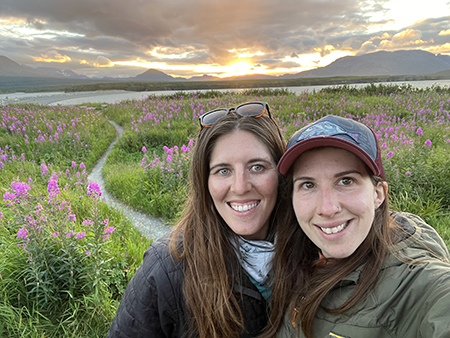
The remainder of the trip to McNeil was spent just like the first two days, with a set schedule of morning meeting, bear viewing, and coming back in the evening. Some bear viewing permit holders hung back to allow the camp standby folks to get out bear viewing. Realistically, a day in camp also includes plenty of bear viewing, and can also include other wonderful things like sauna time, glassing the beach and hillsides for bears and other animals with binoculars or the provided spotting scope, reading, etc. All I wanted to do was be on the river with the bears, so the remainder of my days were spent watching moms and cubs over the fish, learning to recognize specific bears from previous days based on their scars or behavior, and scanning the landscape for other animals. The evenings were spent getting to know the other visitors and enjoying each other’s company. We shared meals, split up camp duties, took shifts in the sauna, and played games until the cook cabin was dark and only the glow of our headlamps was illuminating the table. I was struck by how a group of complete strangers could be thrown into literally the middle of nowhere surrounded by bears and thoroughly enjoy each other’s company from early in the morning, throughout the day, and late into the evening. I felt incredibly fortunate not only for my experience with the bears, but also with the humans, who shared a mutual respect for the sanctuary and the bears.
By the end of my trip, I realized the airhorn in my tent was basically irrelevant, as the balance between humans and bears in the sanctuary had already been figured out. If I followed the human rules, the bears had no reason to visit me in the night. The bigger risk of the airhorn, we joked, was one of us kneeling or rolling onto it in the night, giving the rest of us cardiac arrest from the artificial sound blasting the chorus of nature around us. Courtney was not needed as a human shield, but she was a wonderful companion to share the experience. We still talk about the McNeil bears all the time, wondering how Little Bear is doing, and plotting our next trip to get back to the place where we felt so relaxed and, although this sounds so cliché, one with nature. Along the bank on the McNeil River with no bear protection, or in my thin tent at night, in a place that boasts the highest congregation of brown bears in the world, I slept sounder and felt more relaxed than I have in years. The sanctuary reminded me of the importance of being unplugged and unavailable to reach constantly. With no cell phone service or internet, I realized that life went on without me being available to everyone 24/7, and I needed to do a better job maintaining that balance when I returned home. As our float plane lifted and headed back to Homer on that final day, I only had one thought in mind – I will be back.
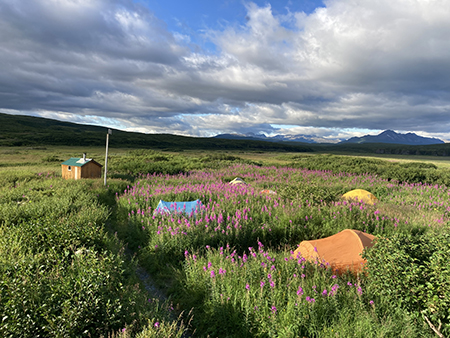
If you’d like to visit McNeil River State Game Sanctuary, there are two main avenues: first, you can apply for the lottery, where you can choose one or multiple permit blocks to apply for. This lottery is open until March 1, and permits for the 2023 summer season are awarded mid-March. All fees for your lottery entry and permit fees (if awarded), directly fund management of the sanctuary. So, even if you don’t win the lottery that year, you still get to support the bears. Click here for more information. The second avenue is through the McNeil River State Game Sanctuary raffle. Click here to learn more about the raffle!
Subscribe to be notified about new issues
Receive a monthly notice about new issues and articles.
